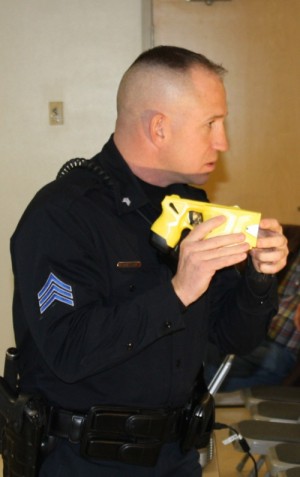
OCEAN CITY –The Ocean City Police Department received the go-ahead this week to purchase eight more Taser devices only days after the request was tabled for more details.
Last week the City Council debated the purchase of eight additional Tasers for the Ocean City Police Department (OCPD) while Mayor Rick Meehan, Council President Lloyd Martin and Councilman Joe Mitrecic were absent.
At that time, OCPD Captain Gregory Guiton presented to the council the department’s desire to use funding in the current Fiscal Year 2013 budget to purchase eight additional Taser X2 Electronic Control Devices (ECD) at a cost of about $11,400 to equip eight certified ECD officers within the department who do not have devices.
The purchase of the eight Tasers under the current budget will reduce the number of ECDs requested in FY 2014 from 22 to 14, as the department continues to outfit all operational officers with the device. The department currently has 26 ECDs in service. The additional eight will allow the department to outfit 37 percent of the officers and first line supervisors serving in an operational role.
The decision was postponed last week as concerns arose among the council, such as is it a beneficial effect on workman’s compensation costs when officers carry an ECD, as well as how the expenditure would impact the looming upcoming budget gap when the remainder of the Tasers are requested.
This week the entire Mayor and City Council returned to council chambers to further discuss the issue. Guiton took the opportunity to address a couple questions raised last week.
Since OCPD implemented the ECD program in February of 2012, the department has tracked 59 uses from simply displaying the device to a warning arc and/or targeting, and in 17 of the 59 uses the device was deployed sending an electrical energy charge to the suspect. This reflects about 71 percent of the ECD uses resulted in compliance by the suspect without deployment. A review of the 17 deployments revealed that alcohol use by the suspect was involved in almost 65 percent of the incidents.
Guiton furthered department records reflect that since the implementation of the ECD program, police officers have encountered 53 incidents involving a suspect actively resisting during an arrest where officers did not have an ECD available to them and injuries were sustained by an officer, a suspect, or an officer and a suspect during 25 of those encounters, representing about 47 percent of incidents. The records also reflect alcohol/drug use by the suspect was noted in almost 79 percent of those incidents.
According to Risk Manager Eric Lagstrom, within workmen’s compensation claims from July 1, 2009 through June 30, 2012, four of the most severe injuries were the direct result of officers having to physically restrain combative suspects. The total amount paid for those cases was about $117,500.
Councilman Brent Ashley presented the room with a report published by Maryland Attorney General Douglas Gansler in 2009 titled, “A Report from the Maryland Attorney Generals Taskforce on Electronic Weapons”.
“The governor’s taskforce gave some examples on workmen’s comp where police departments have instituted Tasers, and for example Granite City, Ill., incurred $740,000 in workmen’s compensation costs. After the department began using Tasers in December of 2002 they had no workmen’s compensation costs for all of 2003,” Ashley explained as he asked Guiton if it was his opinion that if all our officers had Tasers that Ocean City’s workmen’s compensation costs would drop considerably.
“I can give you another statistic that wasn’t included in the report, in which officers arrived at a scene of an incident in which the Taser was available to our officers and in the cases where the ECD was on the scene and utilized 14 percent of either an officer or suspect sustained an injury as opposed to the 47 percent,” Guiton responded. “So there was a great reduction when the ECD was available and deployed, and in all of those cases the injuries were very minor in nature … there were no injuries that required a hospitalization stay or a follow-up.”
Lagstrom added Ocean City’s workmen’s compensation costs have risen over the years but for different reasons. The number of injuries in the OCPD since the Tasers have gone into effect has reflected a decrease as well as the severity of injuries.
“The trend of officers being injured when they are trying to make an arrest and there is an altercation that may take place, that’s now being reduced because of the use of the Tasers,” Lagstrom said. “We still have officers injured in different areas of their work. I think it [workmen’s compensation costs] would be decreased, no question.”
Mayor Rick Meehan voiced his support for the purchase of the eight additional Tasers recognizing the appropriate funding is available.
“The Mayor and City Council moved very cautiously before we implemented this program to begin with. We went through a couple of years of discussion and evaluating what we though the effect of Tasers would be and how they would benefit our department and our community … I was concerned about Tasers but I have seen we have been able to institute a program that is successful and has been working,” he said.
The council voted 5-0, with Ashley and Councilwoman Margaret Pillas abstaining, to approve the purchase of eight additional Tasers for the OCPD. Pillas stated her abstention is due to her concerns over the upcoming budget procedure.
